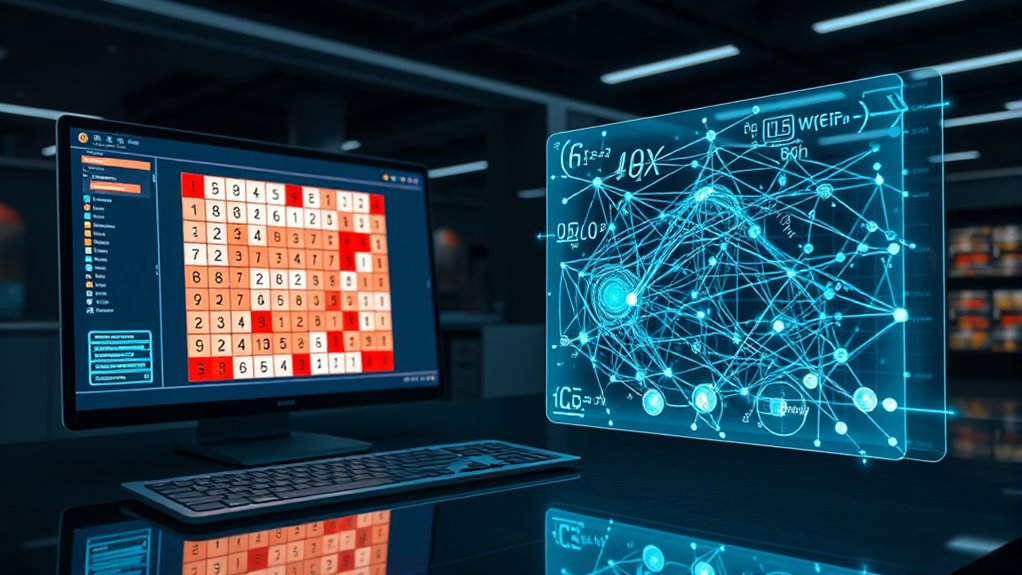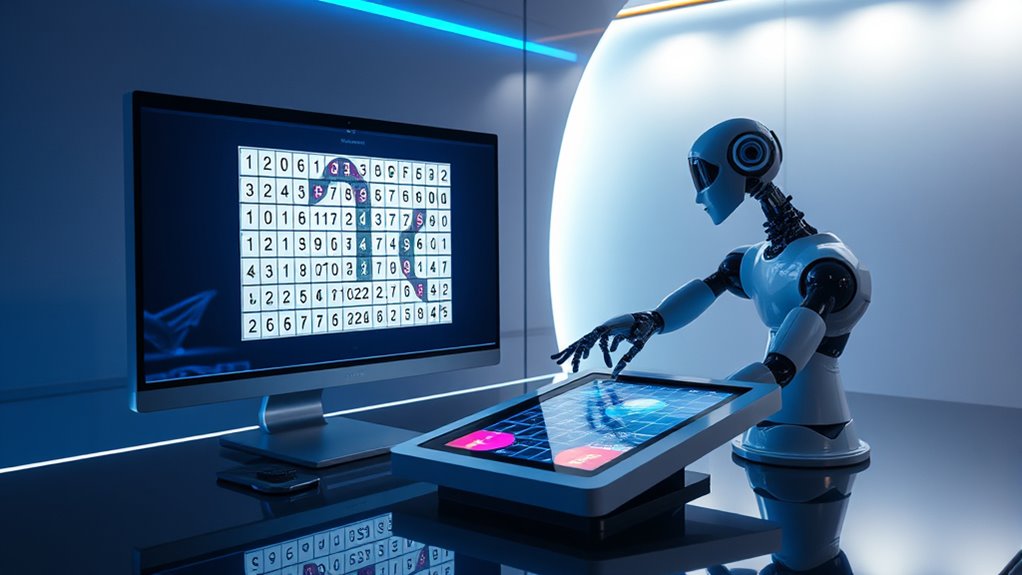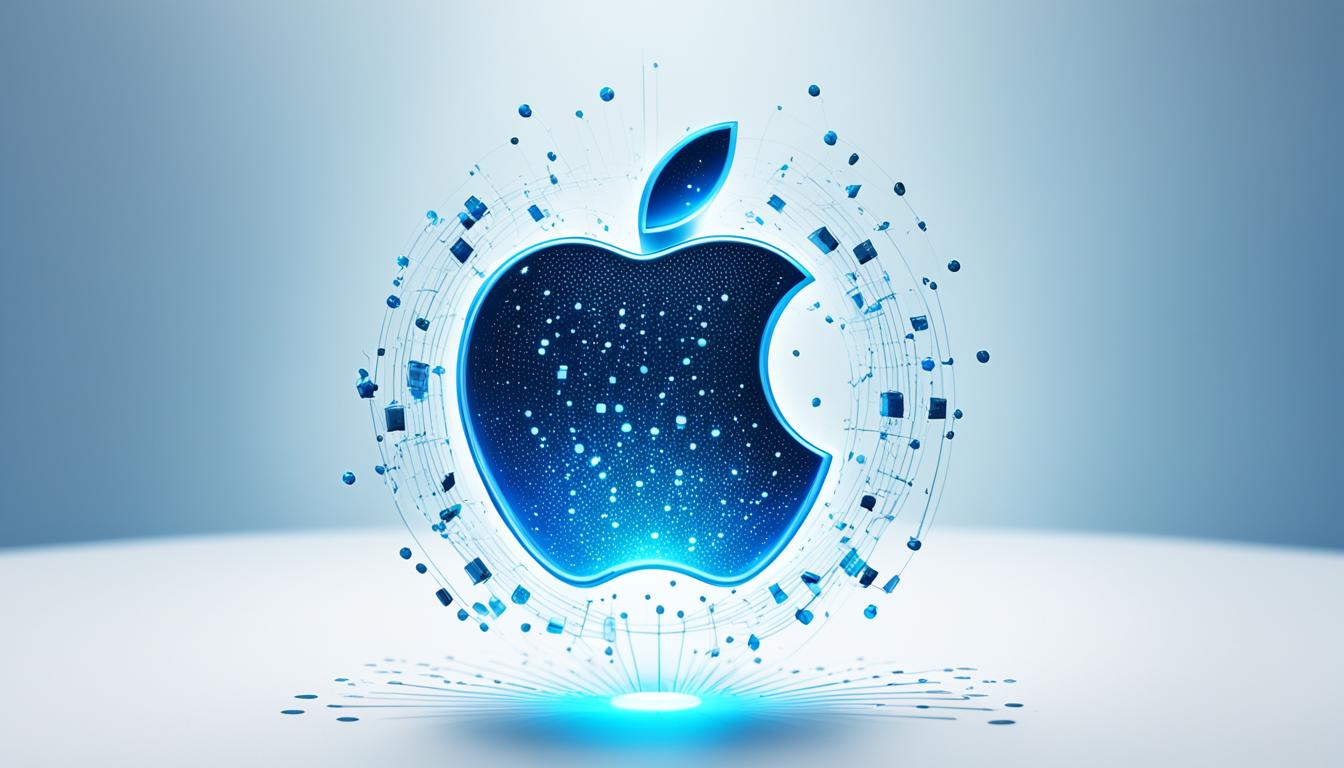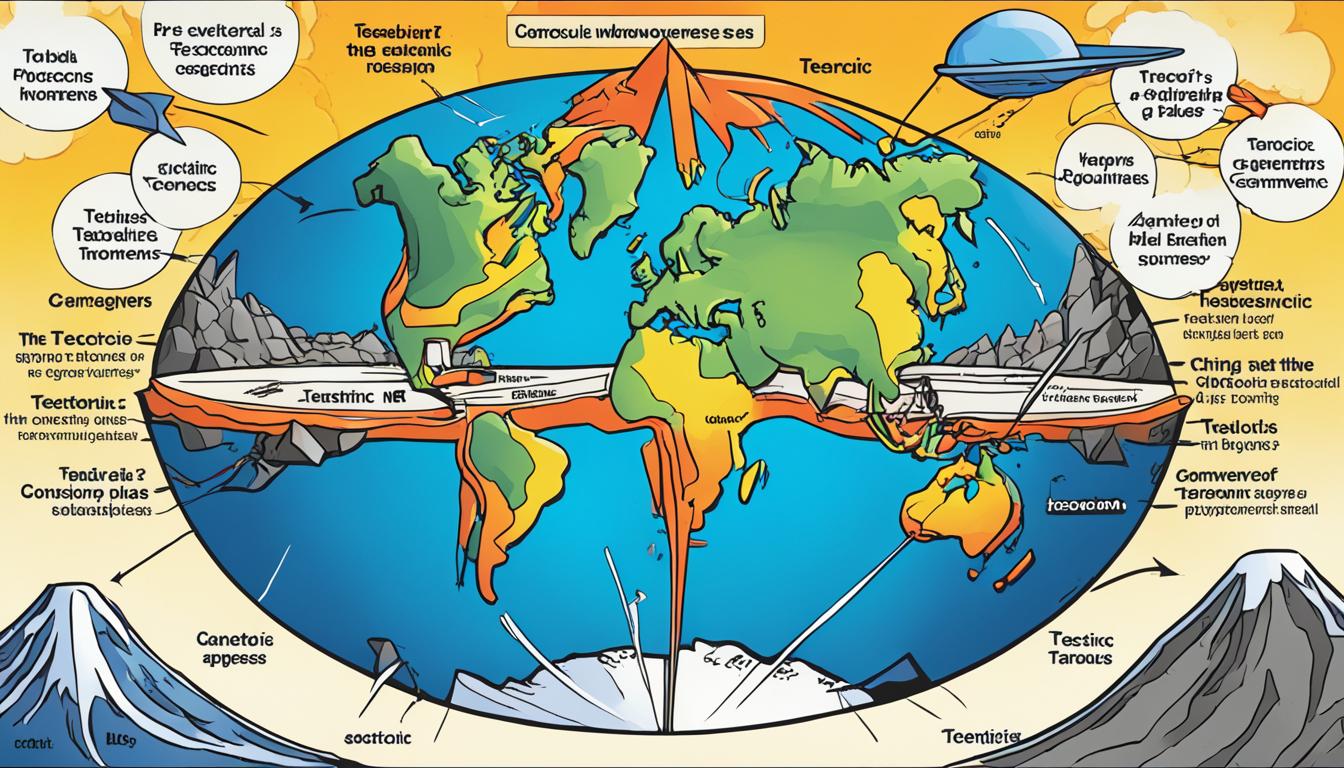The Sudoku‑solving AI learns to teach itself math by combining neural networks with reinforcement learning. It recognizes patterns in puzzles and develops strategies through trial and error, receiving rewards for correct moves. Over time, it refines its problem-solving skills, moving beyond memorization to understanding underlying principles. This self-guided approach makes the AI more adaptable and efficient. Keep exploring to see how this technology continues to evolve and improve its reasoning abilities.
Key Takeaways
- The AI combines neural network pattern recognition with reinforcement learning to develop self-guided Sudoku solving strategies.
- It learns independently through trial and error, improving its problem-solving ability without explicit programming.
- The system adapts by developing mathematical intuition, akin to human logical reasoning, over numerous self-practice iterations.
- Its architecture enables it to understand puzzle structures, improving performance and generalization to new Sudoku puzzles.
- Enhancing neural processing features like contrast ratio detection further refines subtle pattern recognition and strategic decision-making.

Have you ever wondered how artificial intelligence can solve complex puzzles like Sudoku? It’s fascinating to see how AI systems approach these challenges, often outperforming humans. At the core of many successful Sudoku solvers lies a sophisticated process involving neural network design and reinforcement learning techniques. These elements work together to teach the AI not just to recognize patterns but to develop strategies for solving puzzles efficiently.
Neural network design plays a vital role in enabling the AI to understand the structure of Sudoku puzzles. By structuring the neural network with layers that can process the grid’s spatial information, the system learns to identify which numbers are likely to fit into specific cells. This design allows the AI to evaluate possible moves quickly, honing its ability to narrow down options based on the rules of Sudoku. The neural network acts as the puzzle’s visual and logical interpreter, translating the grid into meaningful data that the system can analyze.
Neural networks process Sudoku grids, identifying patterns and narrowing options for efficient puzzle solving.
But just designing a neural network isn’t enough. That’s where reinforcement learning techniques come into play. Instead of programming explicit rules for solving Sudoku, the AI learns through trial and error, receiving feedback after each move. When it makes a correct placement, it’s rewarded; if it makes an error, it’s penalized. Over countless iterations, the system begins to develop an intuition for which moves lead to successful solutions. This process mirrors how humans improve at puzzles through practice, but reinforcement learning accelerates the process dramatically. It enables the AI to discover effective strategies on its own, without external guidance.
The beauty of combining neural network design with reinforcement learning is that the AI isn’t just memorizing solutions; it’s learning underlying principles and patterns that it can apply to new, unseen puzzles. This self-teaching capability allows the system to adapt and refine its approach continually. As it solves more Sudoku puzzles, it becomes more efficient, developing a kind of mathematical intuition that rivals human logic. The AI essentially teaches itself how to think through the problem, improving its performance with each attempt.
In fundamental terms, this combination of smart neural network design and reinforcement learning techniques creates an AI that can independently learn to solve Sudoku puzzles. It’s not just following a set of predefined rules but actively developing its own strategies, much like a human learner. This approach showcases how advanced AI can go beyond simple pattern recognition and move toward genuine problem-solving intelligence—an exciting step forward in the field of artificial intelligence. Moreover, understanding the contrast ratio in the neural network’s processing can further optimize its ability to distinguish subtle differences in puzzle states, enhancing overall performance.
Frequently Asked Questions
How Does the Ai’s Teaching Method Differ From Traditional Education?
You see, the AI’s teaching method differs from traditional education by offering personalized learning tailored to your progress. It actively adapts to your strengths and weaknesses, providing autonomous feedback that helps you improve without waiting for a teacher. Unlike standard teaching, this AI learns from your responses in real-time, making the experience more engaging and efficient, ultimately helping you grasp concepts faster and more effectively.
Can the Ai’s Self-Teaching Approach Be Applied to Other Subjects?
You wonder if the AI’s self-teaching potential can extend to other subjects. Its adaptive learning approach shows promise for cross-disciplinary application, allowing it to explore concepts independently across fields like science, language, or history. By mimicking human curiosity and problem-solving, this method could revolutionize personalized learning, making education more flexible and efficient. The key lies in tailoring the AI’s self-guided strategies to suit different disciplines effectively.
What Are the Limitations of the Ai’s Learning Process?
Imagine your AI as a curious explorer traversing a vast digital jungle. Its learning process faces limitations like overfitting issues, where it becomes too tailored to specific puzzles and struggles with new ones. Additionally, computational complexity slows down progress as it processes extensive data. These challenges mean the AI might not adapt well to different subjects or more complex problems, highlighting the need for balanced, scalable learning strategies.
How Does the AI Handle Ambiguous or Incomplete Math Problems?
When you ask how the AI handles ambiguous or incomplete math problems, it uses ambiguity resolution techniques and relies on incomplete data. You’ll find it attempts multiple solutions, evaluates possibilities, and applies learned patterns to fill gaps. It continuously updates its understanding, using context clues and probabilistic reasoning to navigate uncertainties. This adaptive approach helps it make the best possible decision, even when faced with unclear or partial information.
Will This AI Eventually Achieve Human-Level Understanding of Math Concepts?
You might wonder if this AI will ever truly grasp math like humans do. With advances in neural networks and algorithmic reasoning, it’s making strides, but reaching human-level understanding is like chasing a moving target. It learns patterns and concepts, but understanding deeply requires more nuanced reasoning. While it’s promising, it’s not quite there yet—still a long road ahead before it fully comprehends math as humans do.
Conclusion
Imagine an AI that not only masters Sudoku but also teaches itself math along the way, transforming a simple puzzle into a gateway of endless possibilities. Like a curious explorer charting unknown territory, it pushes boundaries and uncovers new knowledge. This breakthrough isn’t just about solving puzzles—it’s about opening the future of learning and discovery. So, as you watch this AI evolve, remember: the journey of innovation is a never-ending adventure waiting to be explored.










